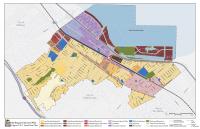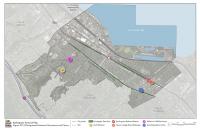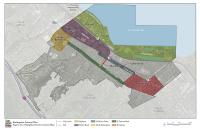Historic Resources
Burlingame has a rich history as one of the earliest complete communities on the Peninsula. San Francisco residents of the late 1800s wishing to escape the city’s cold, foggy summers built grand estates in Burlingame, where they enjoyed sunny weather and beautiful wooded landscapes. Development proceeded in earnest in the 1890s with establishment of the Burlingame Country Club, construction of a train station, and opening of a U.S. Post Office (all existing in 2017, although the country club is in the neighboring town of Hillsborough and the post office has been closed). The station was constructed in 1893-94 on a route that extended from San Francisco to San Jose and is the first permanent structure in the United States built in the Mission Revival architecture style. By the turn of the century, the area featured many estates owned by families drawn by the proximity of San Francisco and the Burlingame Country Club. The first residential subdivision in the area, the “Town of Burlingame,” was completed in 1896, consisting of hundreds of parcels generally 50 feet wide and 150 feet deep. The settlement grew slowly until 1906, when the San Francisco earthquake and fires forced many people to leave San Francisco in search of new homes. By then, a handful of modest businesses had been established around the train station and Burlingame Square, clearing defining the center of this growing community. By 1908, over a dozen additional subdivisions had been recorded in Burlingame.
Figure CC-2 identifies the four officially designated and historically significant resources in the community (as of 2017): Burlingame Train Station, the Kohl Mansion, Howard-Ralston Eucalyptus Tree Rows (along El Camino Real), and Severn Lodge Dairy Wallscape. In addition to the four officially designated and historically significant resources, Burlingame has a wealth of older building stock, neighborhoods, and tree groves that form the basis of the community’s character. For example, the Francard Tree Groves along the Caltrain tracks are eligible for listing on the National Register of Historic Places. The following goal and policies ensure that buildings, neighborhoods, districts, and natural areas with historical significance to the Burlingame community are protected and celebrated so they can remain defining community features that preserve a community character for future generations to enjoy and appreciate.
A comprehensive survey was prepared for Downtown, and the information and findings in the survey, as it may be updated periodically, will inform historic preservation strategies within Downtown.
Goal: CC-3
Protect the character and quality of Burlingame’s historical buildings, tree groves, open spaces, neighborhoods, and districts.
When a structure is deemed to have historic significance, use the Secretary of the Interior's Standards for the Treatment of Historic Properties with Guidelines for Preserving, Rehabilitating, Restoring, and Reconstructing Historic Buildings when evaluating development applications and City projects, or development applications that may affect scenic views or the historic context of nearby historic resources.
Prohibit the demolition of officially designated historical resources unless one of the following findings can be made:
- The rehabilitation and reuse of the resource is not structurally or economically feasible.
- The demolition is necessary to protect the health, safety, and welfare of the public.
- The public benefits of demolition outweigh the loss of the historical resource.


